Health and weight are not connected in the way many people assume. It is possible to have a small body and be unhealthy just as it is possible to have a large body and be in excellent health. We can’t judge a person’s health by only looking at them on the outside. Weight is based on some factors that cannot be controlled, like genetics, side effects from medications and as a result of certain health conditions. However, there are some factors that we can control in order to maintain a healthy weight. These include eating healthy foods, being physically active and having a healthy body image.
Tips for living a healthy lifestyle for kids and teens
Healthy living is more than just the food your child eats. It is also about their lifestyle. Feeling good about themselves, eating well and being physically active are all part of living a healthy lifestyle. People who live healthy lifestyles come in all shapes and sizes, so your child’s healthy weight will be completely unique to them.
Here are the four basic guidelines for helping your child achieve and maintain a healthy weight:
- Be active
- Establish healthy eating routines
- Make healthy food choices
- Talk about weight and size in a positive way
Be active
- Encourage your child to be active in every season (spring, summer, fall and winter). Embrace the outdoors and stay active indoors during poor weather.
- Have them participate in activities they enjoy.
- Try increasing their current activity level. Small bouts of active time add up quickly throughout the day.
- Aim for 60 minutes (1 hour) of activities that increase your child’s heart rate and breathing everyday. These 60 minutes can be done in smaller increments (e.g., 15 minutes) and added up throughout the day. It is also good for your child to do several hours of light intensity activities such as playing, walking to or from school, or doing chores.
- Choose different activities that they like so that they look forward to doing them.
- Active transportation is a great way of sneaking in some activity to your child’s day, like walking or riding a bike to school.
- Limit the amount of time your child spends watching TV and playing on the computer to less than 2 hours per day. Start by reducing their current daily screen time by 30 minutes per day (e.g., no screen during mealtimes or before bed).
Establish healthy eating routines
- Your child should eat three meals a day. They should not skip meals, especially breakfast.
- Healthy routines include eating three meals per day and having something to eat approximately every three hours, which can include 1-3 snacks daily.
- Your child should try to eat within half an hour of waking up.
- Between meals, plan for healthy snacks such as yogurt and fruit, cut up vegetables and hummus, or whole grain crackers and cheese. One to three healthy snacks a day can be helpful in preventing getting overly hungry between meals.
- Have your child eat slowly and without distractions like homework, TV or other screens and toys. That way, they can better sense when they are full.
- See Canada's Food Guide for recommended ratios to aim for and examples of foods that are high in helpful nutrients to the body.
- Eat together at home more often. Try to eat out less often.
- Eat home cooked meals with family more often.
Make healthy food choices

Drinks
- Choose water. If your child does not want water, have them choose from a variety of sugar-free drinks like unsweetened milk or soy-beverages and sparkling water.
- Add sugar-free flavour-enhancing products, mint or fruits like lemon, lime, cucumber or orange wedges to tap water or sparkling water for additional variety and flavour.
Vegetables and fruits
- Choose whole vegetables and fruit with the skin left on for added fiber instead of juice.
- At meal times, fill half the plate with vegetables and fruits.
- Choose vegetables and fruits with a variety of colours, tastes and textures.
- Use herbs, spices and lemon juice to add flavour to vegetables, instead of butter and cream.
- Try out vegetables or fruit with a source of protein for a balanced snack in between meals, like apple with peanut butter spread on top.
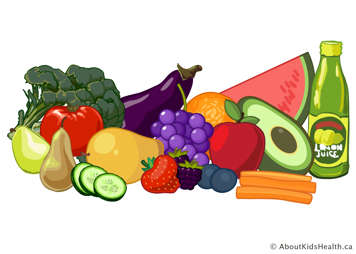
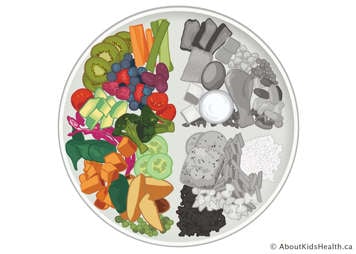
Whole grain products and starchy vegetables
- Choose whole grain breads such as whole grain wheat and whole rye for added fiber. Choose cereals made from whole grains to help increase your fiber intake.
- Try not to eat cereals or granola with a lot of added sugar or fat.
- At meal times, fill one quarter of the plate with whole grains and starchy vegetables like potatoes and corn.

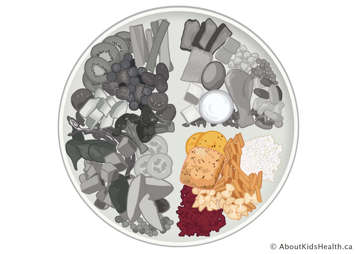
Protein foods
- At meal times, fill one quarter of the plate with protein foods.
- Offer your child plant-based protein foods more often such as legumes, nuts, seeds, tofu and fortified soy beverages.
- Choose leaner cuts of meat, such as loins and rounds, or trim visible fat. Chicken and turkey are lean choices if you take the skin off before cooking them.
- Choose tuna and other fish canned in water instead of oil.
- Limit the use of gravy and cream-based sauces.
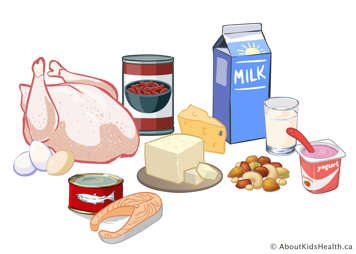
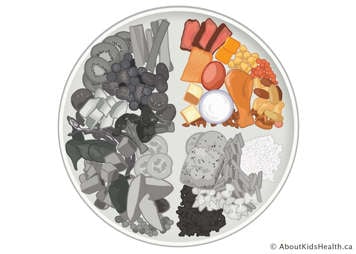
Treat foods
Eating treats occasionally is part of balanced eating and helps prevent us from feeling deprived.
- The key is moderation. If your child eats treats regularly, try decreasing how often they have them.
- You can decrease snacking on treats by not keeping too many treats in the house. If healthy foods that your child enjoys are visible at home, like berries and yogurt or cucumbers with a yogurt-based dip, your child will eat these foods more often.
- Role model healthy eating for your child/children by eating healthy treats that you enjoy.
- Choose healthier treats if you can, or modify treats to make them more nutrient dense. Instead of serving two scoops of ice cream, give your child one scoop with protein-rich nuts and berries as toppings.
- Enjoy treats without guilt during holidays and other special events. Treats served on special occasions, like birthday cake, can be important because food plays a role in our emotional health. If we allow ourselves and our children to eat treat foods sometimes, we will be better able to enjoy moderate amounts of treat foods when we do have them.
Talk about weight and body size in a positive way
- Remember that healthy bodies come in different shapes and sizes.
- Focus on the positive changes your child has made to their lifestyle.
- Do not have your child weigh themselves often. Do not compare different scales.
- Reward your child’s efforts with non-food rewards. Their hard work deserves to be recognized.
- Be a healthy role model. If you are positive about your body, your child will be more positive about their body. If you practice healthy eating routines, your child is more likely to practice them too.
Further information
Visit Meant2Prevent to find more resources about the importance of healthy living and lifestyle habits.
For some healthy recipe videos, watch SickKids dietitians make: